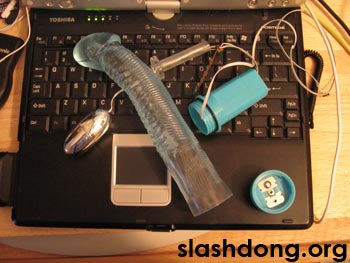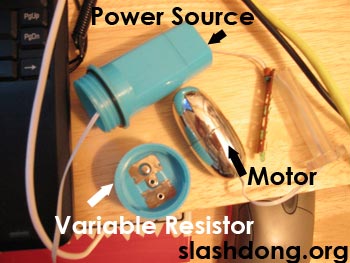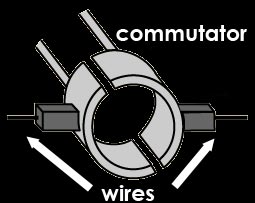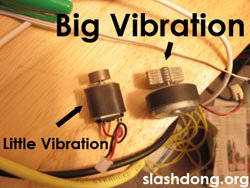How Shit Works - Vibrators
How Shit Works: Vibrators

Vibrators, the ubiquitous sex toy
Vibrators. You know them, you love them. These vibrators, they vibrate.
Almost all sex toys these days are based on some type of vibration, which is interesting seeing that finding a human that will vibrate in similar ways to a vibrator while having sex can easily cost you hundreds of dollars a night. However, put something vibratey on a body part, and there's a damn good chance it's going to feel good. From Hitachi Magic Wands to LED Dildos to your washing machine on spin cycle, vibrators are most likely responsible for far more orgasms than men and women combined.
So, fair reader, you stick these things in your sensitive areas (and vice versa), yet have you done the research to know how they work? Are you sure they aren't giving you some sort of vibrational cancer? Do you know how hard the little men inside them have to work?
Didn't think so.
Small Serious Sidenote: This is my first time writing tutorials on things like this, and I'm not sure how good I am at it yet. If I go too fast, too slow, or am too silly and cloud the explanations, please email me and tell me. I would like people to actually learn stuff from this, but as any high school or college student will tell you, it can be boring as hell if presented as such. Also, all of this information is available in non-sex form around the net. None of this is really specific to sticking things in/around your hoohoo, I just interject points about that in order to make it readable.
A little bit o' history
There's about a million references on the history of both vibrating motors and orgasm causing motors all around the web. Since we're an engineering page, we realize that history is for hippies and should be forgotten as soon as it happens. In the interest of said hippies reading this page and hopefully telling their friends, we'll include a little history here. We're nothing if not hit whores.
That being said, we do not claim any of this history to be correct in any way, but we try to at least get kinda close.
Picture it -- Sicily, 192... er, Greece, sometime before I was born. Women use oblisos (basically an early form of non-vibrating dildos) to get off. Before that, sexual implementations were used for rituals and by the Asians (they do everything first you know), but that's the first time that someone recorded it, so we'll start there.
So, now, we have non-moving sex toys. Yay. It stays that way for around 1900 or so years. Aren't you glad you didn't live back then? Everyone must've been really thick wristed.
Anyway, 1869 rolls around. George Taylor invents the first steam powered vibrator (we hope to carry these at the slashdong store soon, to cater to the future rise in Steampunk Porn). Rather then being used as a toy for pleasure, it was used to cure women of hysteria and any other mental issue doctors could think up. So remember, next time you call someone "hysterical", it literally means "suffering uterus". It's so much faster than saying "sand in the vagina".
15 years later, the first electric vibrator comes on the market, created by Joseph Mortimer Granville. However, this one was created to massage the muscles of men, a wonderful excuse still used to this day so that you can buy your sex toys at Wal-Mart and WalGreens.
In the 20s, vibrators started showing up in silent porn as masturbatory aids. Even so, a couple of decades later, hysteria goes the way of the humors in terms of medical relevancy, and the vibrator disappears...
- Peace, love, and dirty, dirty hippy sex. Lots of it. But, get a lot of drug-fueled peaceniks together, and old medical devices become new again. The vibrator makes a resurgence, and with the consumer market buyin, is here for good this time.
Since then, we've had cyberskin, rabbit vibes, ergo vibes, eggs, and every other type of vibrator that you could imagine. But you still don't know how they work yet.
A lot of basic physics theory
When I say basic theory, I MEAN basic theory. I will be using as few equations as possible. This is just an overview. I will provide an asston of links in the references section that I strongly urge you to check out, but I've gotta keep people interested in both sex and engineering at the same time, and I find that math turns a lot of people off very quick. If math turns you ON, and you need a partner, email me. I know people who need other people. I seem to be a matchmaker for people like this.

Image: The insides of the infamous Jelly Dong (ignore the LED circuit)
So first off let's consider what's inside today's vibrator: you've got a vibration motor, 2 batteries, and some sort of variable resistor, usually a rheostat. We'll work on the motor part first.
Magnets are the base of how DC motors operate. As you'll remember from what should very well be common knowledge for ANYONE who's a fan of Paula Abdul, opposite poles (and cartoons cats and singers, generating hopes for many a furry in the late 80's) attract. Likewise, like poles repel.
Electricity generates magnetic fields. We are working with DC, or direct current. This means that the current is always flowing in the same direction. Imagine it like water flowing down a pipe. Electrons start at the negative end of a circuit, and flow to the positive end. This flow creates a magnetic field in the wire. The magnetic field generated by the wire will be dependant on the direction of flow of electrons in the wire, so if you flip the connections on the ends of the wire, the opposite magnetic field will be produced. The smart ones of you will already be seeing how we create a motor with this. The rest of you, well, someone's gotta cook the fries.
A basic DC motor consists of a wire, two magnets, and a commutator. The wire is run in a loop through the commutator, so it is situated in a U-type shape between the two magnets. One end of the wire hooks to the negative side of a power source (in our case, usually 1 or 2 AA batteries), the other end hooks to the positive end of the power source. Electrons flow from the negative side of the power source, through the wire to the positive side. Since electrons are flowing, that means the wire is creating a magnetic field with some type of polarity. Opposites attract, torque (or rotational force, the same type that you produce when using a wrench) is created, so the wire will rotate until it is lined up in the correct position with the magnet so that the North-South fields are next to each other. Yay! We have a motor that will turn up to one half turn then stop!
 Image: A picture of a commutator
Totally ganked from this link
Image: A picture of a commutator
Totally ganked from this link
This is where the commutator in. Every half turn, the commutator (which is basically a ring with two gaps, great picture of one here) switches the current on the wires, meaning the magnetic field flips over! Now it'll go on until the power source is removed, either through unplugging or dead batteries.
A smidge more physics theory
You've got a spinning wire now. That's certainly neat, and you've advanced civilization to the point where you can really start fucking shit up, but it's not quite to the point of getting you off. To REALLY start up the fun, you need to add some load to that motor.
Unbalanced load is where the vibration comes from. Ever had a clothes washer that started walking? That's an unbalanced load. Spinning something in a circle with more weight on one side of the circle than the other will cause an outward force, either on your poor appliances or on your orifice walls.
Vibration motors usually have a half circle of metal on top (it's actually a sort of ball bearing). The weight of this chunk of metal will determine both how much power it takes to get it spinning (heavier load requires more startup power), and how much outward force it will generate (which gives you the choice of a petit morte or an intestine liquefying jizz flash flood).

Image: Vibrators from an Xbox Controller
Thus ends the shortest tutorial on circular forces, ever.
A fuckload of electronics theory
Let's put together the parts we understand at the moment. We've got
our batteries, which have positive and negative ends, so that
electrons will flow from one side to the other (that's as deep as I'm
getting with batteries). We've got a motor, which will spin things in
a circle. We've got a weight on the end of that motor, which will
create some sort of spinny-really-fasty-outwardy force, better known
as vibration. But we're local modern people with
local modern needs! We need to feel the smallest
shudder and the ginormousest earthquake! So how do we do that? By
varying our voltage!
So, you've got your voltage (which correlates to the amount of water, since we're still using that example) flowing around your wire. Assuming there is any resistance in the wire (which there is right now, through the motor), the sum of all voltage drops across those resistances (difference in how much water goes in versus is "left over" when it comes through the other side, to stretch our example way, way too far) is equal to the total voltage in the circuit.
Right now, all we've got in the circuit is the motor. The motor causes resistance (through means I'm not going into, just trust me, it does), so the motor is accounting for the full voltage drop, which is causing it to go as fast as it can. If we add some other resistance somewhere else in the circuit, the motor will not be getting as much power, which will cause it to slow down. This is where our variable resistor comes in. Variable resistors (Or potentiometers and rheostats) are resistors that are variable. Yay for obviousness! In our case, vibrators usually use rheostats. A rheostat usually has two connections (one positive, one negative) and a knob to control how much resistance happens between the two connections (along with a setting that disconnects the circuit completely, so you can turn things off). Turn your vibrator on, and it's vibrating just a little bit, which means the rheostat is set to a high resistance level. Keep turning, and the motor goes faster, meaning the rheostat-generated resistance is dropping. All the way up, and your motor is whirring along with very very little resistance.
A teensy weensy bit of hot sex0rz
Now we've got a power source, a motor, and a way to control how fast that motor goes. All we need to now is pack the setup into something similar to a penis, or at least, an elongated hard plastic bullet (because some people enjoy that shit, weirdos). We're ready to get off as long as we can afford batteries! Sure, you can say "it's not as good" or "it's expensive" or "I'm Amish", but when it comes down to it, the vibrator is a quick, always there way to get it on wit' yo' bad self.
A smattering of references
On the history of vibrators
Mypleasure - A history of sex toys - This is where I ripped most of my info from, hope it was right
DC Motors
A page with a ton of good pictures and explanation about DC Motors
How Stuff Works - Motors - A much better explanation of 80% of what I talked about.
Electricity
How Stuff Works - Electricity - A much better explanation of the other 20% of what I talked about.

